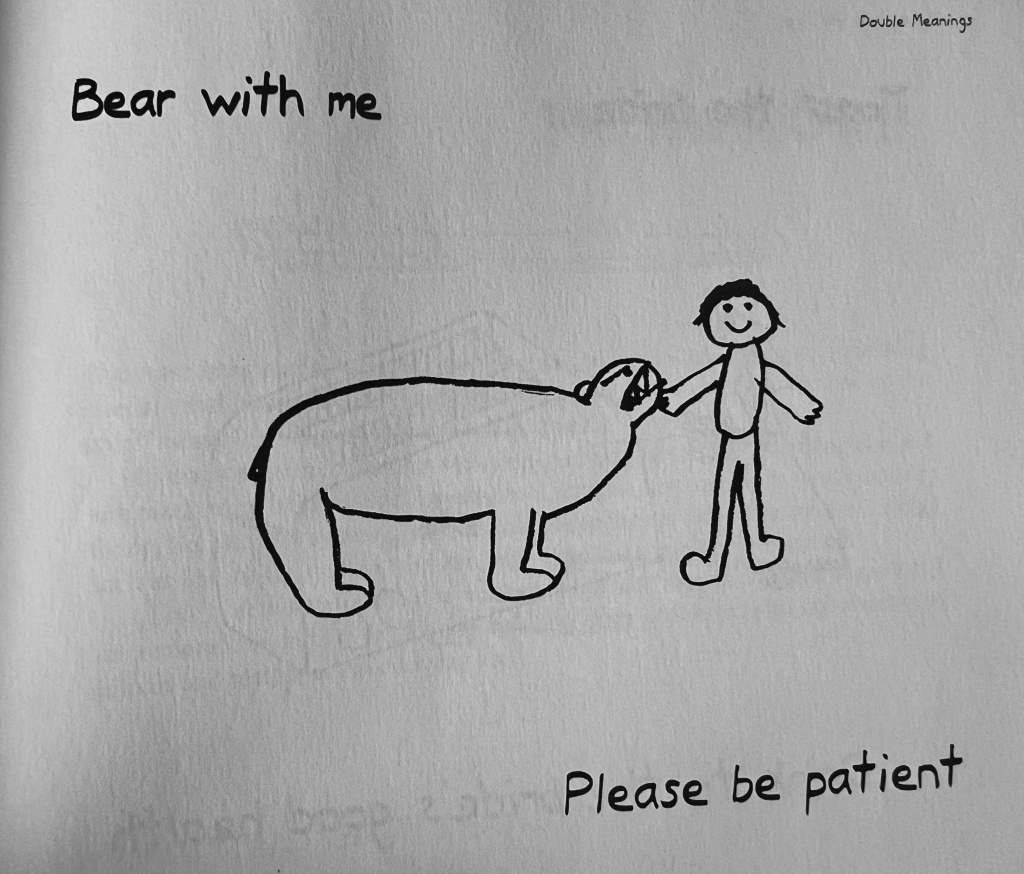(Featured image taken from It’s Raining Cats and Dogs – An Autism Spectrum Guide to the confusing world of idioms, metaphors and everyday expressions by Michael Barton. )
I thought I knew English, then I had a child! Having a child makes you really recognise and hear your language choice because ultimately they behave like a parrot. They will pick up on words and phrases that you use often and say it back to you. I remember thinking – oh, do I say that? Or thinking, where did they pick up that? and then a few moments later repeating the same words… Children learn through copying. It has been researched over and over again that copying behaviours and mannerisms of others is influential in a child’s social and cognitive development.
As well as copying language, we have the added complexity of a child who interprets things very literally and this makes you question the English language all over again! In the book What Works for Autistic Children by Luke Beardon, he starts off the book with a great example – “For those of you who don’t know me, my name is Luke”. I’m assuming majority of the people who read that sentence didn’t think twice about it – ok, his name is Luke. Now let me demonstrate to you how else that can be interpreted:
What do you mean your name is Luke for those of you who don’t know you? What is your name for the people who do know you? Why is it different? And now that I’ve gotten to know you, what name should I use for you?
You can start to see now how confusing it can be from a simple expression that was said with good intention.
When working with children, particularly if you are providing instruction, it is critically important that you use unambiguous, clear language that cannot be misinterpreted in multiple ways. Here are two common mistakes that I’ve seen in software:
- The use of sayings and expressions
- Questions where there’s only one expected answer
The use of sayings and expressions
Today in day to day conversation we have integrated many sayings and expressions. For someone who interprets things literally, these can be confusing, can disrupt a whole conversation or cause anxiety as they aren’t sure what to do next. Imagine having a conversation with someone about the weather and they suddenly start talking about cats as if that was the same thing as the weather. You would be left feeling confused, perplexed and not sure how to respond.
For example, I told my daughter to “hop into the car”. She stopped, looked at me curiously and very innocently said – “Mum, I can’t hop that high.” On a different day, I told her i’d “kick her out of the room” (if she didn’t stop annoying her sister). She immediately got upset and said – “Please don’t kick me!” Now I definitely wasn’t going to kick my child but I can understand how in that moment, based on the words I’d used, she thought I was going to kick her and became incredibly anxious and scared.
Here are some other examples of sayings and expressions that we use often:
- You’re pulling my leg
- He chickened out
- I’m feeling under the weather
- I was over the moon
- It’s a piece of cake
- I’ve got some time on my hands
- It’s hard to get your head around it
- I laughed my head off
- Put the kettle on
- I feel like a pizza
- You’ve hit the nail on the head
- You took the words right out of my mouth
Similar to the example above, let me demonstrate how these can be confusing for someone who interprets things very literally and hasn’t learnt these sayings before.
I’ve got some time on my hands – How can you hold time? and where is it on your hands?
It’s a piece of cake – where is the cake? What does the cake have to do with what we’re talking about? Why are you suddenly talking about pieces of cake?
Put the kettle on – Put the kettle on what? I can turn the kettle on, but I’m not sure what to put the kettle on..
I feel like a pizza – How can you feel like a food? My body feels like my body, my body does not feel like any type of food.
A great book that visualises these in a fun way while also explaining their meaning is It’s Raining Cats and Dogs – An Autism Spectrum Guide to the confusing world of idioms, metaphors and everyday expressions by Michael Barton.
Another great example of these in literature is the classic book Amelia Bedelia, by Peggy Parish. For those of you not familiar with the story, it involves Amelia Bedelia repeatedly misunderstanding various commands her employer has asked of her by taking figures of speech and terminology literally. For example, she’s asked to “change the towels“, and she states she’s confused because they’re nice looking towels, but proceeds to cut them into shapes so that they are changed. When asked to “put the lights out“, she hangs them on the line and to “dust the furniture“, she applies dust powder to them. In the end, the family realises their mistake and create a new set of instructions that are more explicit such as “un-dust the furniture” and “put the wet towels in the laundry and replace them with clean dry ones“.

These all seem fun and light hearted but they can get in the way of understanding how to use a product. A recent example I saw was in an application for children where the narrator said – Keep an eye on it. We know this means pay attention to it, but for a child who interprets things literally they may try to put their eye on it. We ended up changing this to “Make sure your eyes are watching the character.“

Questions where there is only one expected answer
“Are you ready to play?”
“Would you like to continue?”
When working with an occupational therapist on reviewing language, we came to these types of phrases in a game and she very simply said – what if the child says no? I remember sitting there and going, well… they don’t really have a choice. I mean they can switch off the tablet. To which she replied – so why ask them? It’s a great point, as we’re asking a question and not actually expecting a reply, or only really expecting one answer. The best approach in these situations is to turn the question into a statement.
“Are you ready to play?” turns into “It’s time to play.”
“Would you like to continue?” can turn into “We can continue now.”
It’s best to express information or requests directly and explicitly instead of asking questions. In everyday conversation this may look like “It’s time for lunch” rather than “Are you ready for lunch?“
For a better understanding of this, the most effective approach is to delve into the details of Declarative language. Declarative language is about structuring communication in a clear and straightforward manner that focuses on conveying information, statements and descriptions. The intent is to reduce confusion for anyone who may have challenges with language processing, social cues or abstract ideas. The “Declarative Language Handbook: Using a thoughtful Language Style to Help Kids with Social Learning Challenges Feel Competent, Connected and Understood” by Linda Murphy is a great resource for this.
Now that you know, listen and notice carefully (i.e. “keep an ear out”) for what sayings you might use in everyday conversation, and how you can communicate without confusion for someone who may have trouble understanding it.
If you are in a position where you are reviewing or designing products, then please review your language choices and how you phrase instructions to ensure that words don’t become a barrier for some of the population. If you need any help, then reach out!


Leave a comment